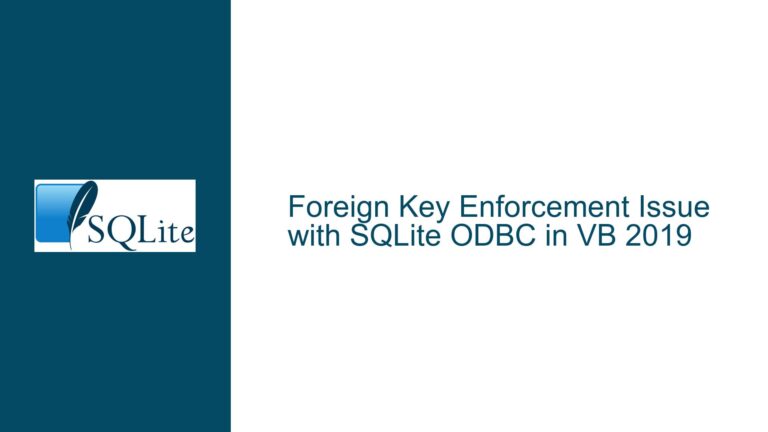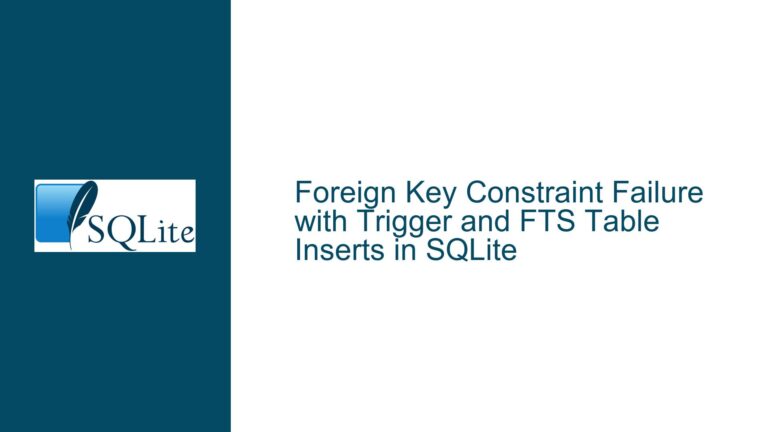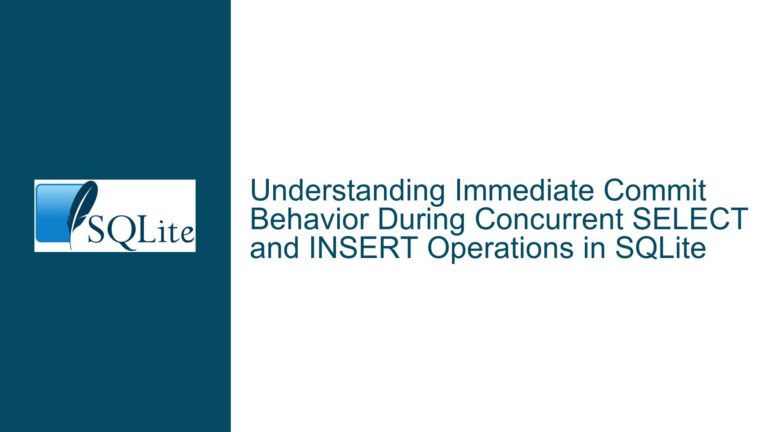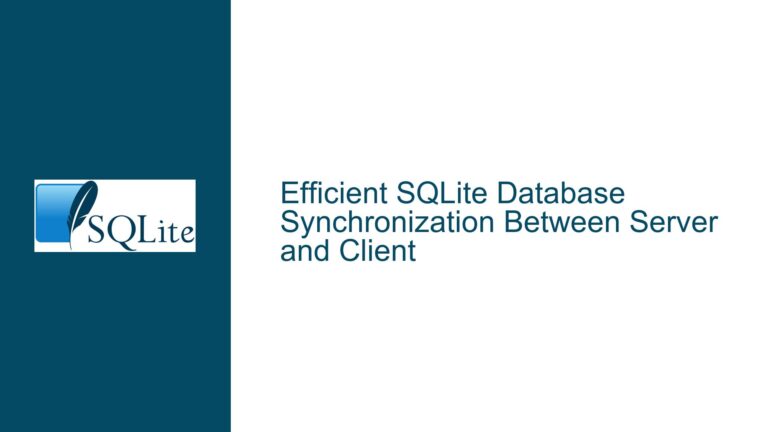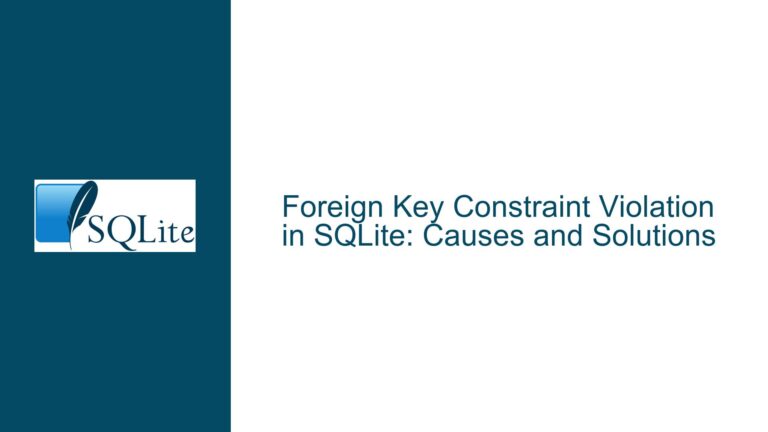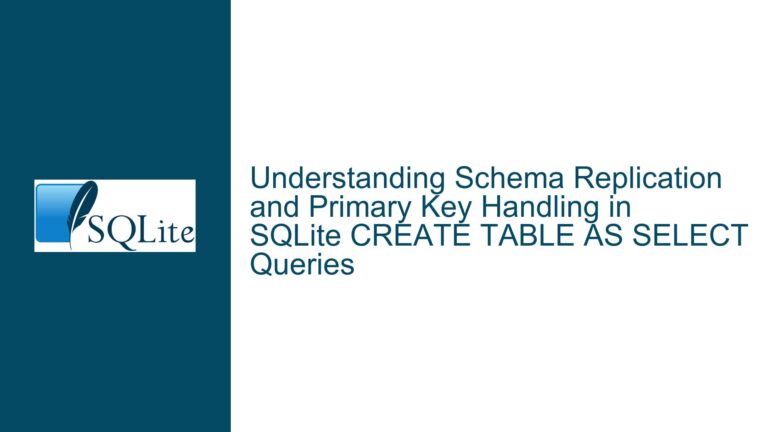SQLite BEGIN CONCURRENT Transaction Behavior and Locking Strategies
Transaction Start Timing and Snapshot Visibility in SQLite
SQLite transactions operate under distinct modes that govern their interaction with the database engine’s locking mechanisms and snapshot visibility. The core challenge arises from the interplay between three critical concepts: transaction initiation timing, lock acquisition strategies, and snapshot isolation. A DEFERRED transaction delays both lock acquisition and snapshot establishment until the first database access, while an IMMEDIATE transaction acquires a reserved lock and establishes a snapshot at the moment the transaction begins. The CONCURRENT transaction mode introduces a hybrid approach designed for write operations that defer lock conflicts until commit time, but its interaction with snapshot visibility creates unique challenges.
When a transaction begins with BEGIN CONCURRENT, SQLite defers the acquisition of the RESERVED lock—a prerequisite for writing to the database—until the commit phase. This allows other writers to proceed concurrently, as the locking conflict resolution occurs only during the final commit step. However, the transaction’s snapshot—the consistent view of the database state it operates on—is still determined by the moment the transaction first accesses the database. This creates a scenario where the transaction’s logical "start time" (snapshot establishment) is decoupled from its lock acquisition strategy. Developers expecting BEGIN CONCURRENT to immediately establish a snapshot will observe that the transaction remains inactive until the first SELECT, INSERT, or other data access operation. This behavior mirrors BEGIN DEFERRED, where the transaction only materializes upon initial database interaction.
The visibility of concurrent commits further complicates this model. A transaction started with BEGIN CONCURRENT will not see changes committed by other transactions after its first database access. For example, if Transaction A begins with BEGIN CONCURRENT at time T1 but executes its first query at T2, any commits occurring between T1 and T2 will be invisible to Transaction A. This contrasts with BEGIN IMMEDIATE, where the snapshot is established at T1, freezing visibility to the database state at that exact moment. The decoupling of transaction initiation and snapshot timing in BEGIN CONCURRENT creates ambiguity for developers requiring strict control over visibility windows, particularly in high-concurrency environments.
Lock Acquisition Strategies: DEFERRED, IMMEDIATE, and CONCURRENT
SQLite employs a tiered locking system to manage concurrent access, with locks escalating from UNLOCKED to SHARED, RESERVED, PENDING, and finally EXCLUSIVE. The choice of transaction mode directly influences how these locks are acquired and released, impacting both concurrency and isolation. A DEFERRED transaction begins in the UNLOCKED state, acquiring a SHARED lock on first read and a RESERVED lock on first write. This maximizes concurrency but risks transaction abortion if a reserved lock cannot be acquired later. An IMMEDIATE transaction escalates to a RESERVED lock immediately, blocking other writers but allowing concurrent readers.
The CONCURRENT transaction mode, introduced in SQLite version 3.37.0, modifies this paradigm by deferring the RESERVED lock acquisition until commit time. This allows multiple CONCURRENT transactions to coexist, as they operate under the assumption that their writes will not conflict. The commit phase then performs conflict resolution: if no overlapping writes occurred, the transaction commits; otherwise, it rolls back. This design optimizes for write-heavy workloads where conflicts are rare but concurrency is critical. However, the deferred lock acquisition means the transaction cannot preemptively reserve write access, creating a trade-off between concurrency and commit success probability.
A critical misconception arises when developers attempt to combine BEGIN CONCURRENT with IMMEDIATE behavior. The syntax BEGIN IMMEDIATE CONCURRENT is invalid because the locking strategies are mutually exclusive: IMMEDIATE requires an immediate RESERVED lock, while CONCURRENT explicitly avoids it until commit. This incompatibility stems from the fundamental design of these modes. The CONCURRENT mode’s value lies in its ability to allow other writers to proceed, which would be negated by acquiring a RESERVED lock upfront. Developers must recognize that snapshot timing and lock acquisition are orthogonal concerns: while IMMEDIATE transactions control both simultaneously, CONCURRENT transactions separate them, prioritizing commit-time conflict resolution over upfront locking.
Resolving Conflicts Between Transaction Timing and Locking Requirements
To address scenarios requiring both immediate snapshot visibility and concurrent write capabilities, developers must reconcile SQLite’s transactional constraints with application requirements. When an immediate snapshot is non-negotiable—such as in financial systems requiring point-in-time consistency—the BEGIN IMMEDIATE mode remains the only option, despite its concurrency limitations. However, this approach serializes writers, creating bottlenecks in high-throughput environments. For applications prioritizing write concurrency, a hybrid strategy can be employed: use BEGIN CONCURRENT followed by an immediate no-op read operation to force snapshot establishment. Executing SELECT 1; after BEGIN CONCURRENT triggers the database access required to finalize the transaction’s start time and snapshot, providing predictable visibility without sacrificing the benefits of deferred lock acquisition.
In cases where write conflicts are likely, proactive conflict detection mechanisms must supplement BEGIN CONCURRENT usage. This involves querying system tables like sqlite_schema or application-defined version counters to infer potential conflicts before committing. For example, a transaction could read a "version" column from a control table at the start and re-check it before committing. If the version has changed, the transaction aborts early, reducing the cost of failed commits. Additionally, leveraging SQLite’s Write-Ahead Logging (WAL) mode enhances concurrency for CONCURRENT transactions by allowing simultaneous readers and writers, though it does not eliminate the need for careful conflict management.
Architectural adjustments may also mitigate these constraints. Decoupling read and write operations into separate transactions can isolate snapshot requirements: use an IMMEDIATE transaction for critical reads requiring stable visibility, and a CONCURRENT transaction for subsequent writes. This pattern sacrifices atomicity but preserves concurrency. Alternatively, employing application-level locking mechanisms—such as advisory locks stored in a dedicated table—can coordinate access without relying solely on SQLite’s transactional locks. These strategies require careful implementation to avoid deadlocks but offer flexibility when native transaction modes fall short. Ultimately, the choice hinges on whether the application prioritizes consistency, concurrency, or a balanced compromise between the two.

